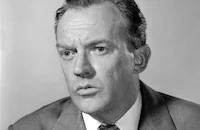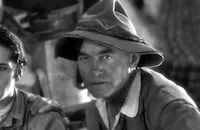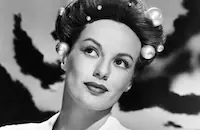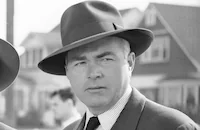Air Force

Brief Synopsis
Cast & Crew
Howard Hawks
John Ridgely
Gig Young
Arthur Kennedy
Charles Drake
Harry Carey
Film Details
Technical Specs

Synopsis
At a San Francisco Air Force base, the crew of a B-17 Flying Fortress, nicknamed the "Mary Ann," prepares for a routine flight to Hawaii. The crew, consisting of Captain Irish Quincannon, co-pilot Bill Williams, bombardier Tommy McMartin, navigator Monk Hauser, crew chief Robbie White, assistant crew chief Corporal Weinberg and radio operator Peterson, are joined by two new soldiers, assistant radio operator Chester and aerial gunner Joe Winocki.
This is Chester's first flight and he is enthusiastic about it. Winocki, on the other hand, had wanted to be a pilot, but failed flight school and now, bitter about his disappointment, is counting the days until his enlistment is over. As the Mary Ann flies over the Pacific on 7 December 1941, the crew hears Japanese voices over their radio and soon learns that Hickam Air Field in Pearl Harbor is under attack. The news turns Winocki's cynicism around, and he announces that he is now in the air force for the duration of the war. The flight is diverted to an emergency air field on Maui, where the crew finishes emergency repairs just before fifth columnist snipers advance toward the plane. Despite the danger, the Mary Ann heads for Hickam. When the crew lands, they learn that McMartin's sister was wounded during the bombing. They have time to visit her briefly in the hospital before they are sent out, fully armed, to Manila, which has also been devastated by Japanese bombers. Flying along with the crew is pursuit pilot Tex Rader.
Before a fuel stop on Wake Island, they receive a shortwave communication reporting that McMartin's sister will recover. The Marines on Wake, knowing that they are facing almost certain annihilation, hand the Mary Ann's crew letters to mail to their families and also persuade them to take their little dog Tripoli along with them when they leave for Manila. White is eager to reach Manila because his son is a pilot with the air force there. Upon landing at Clark Air Force Base, however, he receives the sad news that his son was killed during the first Japanese strike. The Mary Ann is loaded with bombs and when the Japanese return, the crew engages in a fierce battle during which Quincannon is fatally wounded, and Chester is also killed. Back on the ground, the crew hurriedly salvages parts from other planes to rebuild the badly damaged Mary Ann.
When Manila falls to the Japanese, the Mary Ann heads for Australia with Rader as their new co-pilot and a former Marine as assistant radio operator. On the way they spot a Japanese fleet and radio their position to the Allied fleet. During the ensuing battle, the Japanese are routed. Later, the men prepare to lead an attack on Tokyo.

Director

Howard Hawks
Cast

John Ridgely

Gig Young

Arthur Kennedy

Charles Drake

Harry Carey

George Tobias
Ward Wood
Ray Montgomery

John Garfield
James Brown

Stanley Ridges
Willard Robertson

Moroni Olsen

Edward S. Brophy

Richard Lane
Bill Crago

Faye Emerson

Addison Richards

James Flavin

Ann Doran

Dorothy Peterson
William Forrest
Maurice Murphy
Henry Blair

Warren Douglas
Ruth Ford

Lynne Baggett

Marjorie Hoschelle
Leah Baird
George Neise
William Hopper
Sol Gorss
Charles Flynn

Walter Sande
Victor Zimmerman
Pat Gleason
Edward Soo Hoo
Walter Soo Hoo
Bill Edwards
Charles Lang
James Bush
Jr. George Offerman
Murray Alper
Warren Mace
John Estes
Hal Welling
Theodor Von Eltz
Ross Ford
Edwin Stanley

Rand Brooks

James Millican
Bill Hunter
Allan Lane
Bill Kennedy

Tom Neal
David Alison
Charles Sullivan
Pat West

Fred Steele
Frank Marlowe
Harry Lewis
Crew
George Amy
Milo Anderson
Major Theron Coulter
Roy Davidson
Elmer Dyer
Leo F. Forbstein
Oliver S. Garretson
Howard Hawks
Arthur Horman
James Wong Howe
John Hughes
Hans F. Koenekamp
Nathan Levinson
Paul Mantz
Charles Marshall
Dudley Nichols
Jack Sullivan
Walter F. Tilford
Major Sam Triffy
Jack L. Warner
Franz Waxman
Perc Westmore
Rex Wimpy

Photo Collections
Videos
Movie Clip




Trailer
Hosted Intro
Film Details
Technical Specs

Award Wins
Best Editing
Award Nominations
Best Cinematography
Best Special Effects
Best Writing, Screenplay
Articles
Air Force
In addition to its stunning aerial scenes, Air Force focuses on the personal dramas of its representative crew, which includes Garfield’s thwarted ambition to become a pilot and Carey’s loss of a son. Hawk’s overriding theme is the importance of teamwork and collective responsibility in winning a war. "It takes all of us to make this ship function," Ridgley tells the other men. A veteran of the Air Corps of World War I, Hawks clearly reveals his reverence for the service and his aptitude for stories about a group of professionals unifying to face a common enemy. Effective as wartime propaganda, Air Force later won criticism for its anti-Japanese slurs and its erroneous indication that the Hawaiian population provided a "fifth column" that had Japanese snipers infiltrating ground facilities at Pearl Harbor.
This archetypal film won an Oscar for Best Film Editing and three other nominations, for Best Original Screenplay, Cinematography and Special Effects. Hawks’ friend William Faulkner was an uncredited contributor to Dudley Nichols’ screenplay. Among Faulkner’s contributions was a pivotal death scene and some sharp bits of dialogue including Tobias’ assessment of California: "The sun shines and nothing ever happens, and before you know it you’re 60 years old."
James Wong Howe and his associates won much praise for their black-and-white cinematography, which blended some newsreel footage with striking simulations of battles. A real "flying fortress" was used for many of the film’s exterior shots. The bomber was later returned to active duty in the Pacific and, shortly after the film’s release, was lost at sea along with its entire crew. The interior shots were filmed inside a $40,000 replica of the plane.
Producer: Hal B. Wallis
Director: Howard Hawks
Screenplay: Dudley Nichols, William Faulkner (uncredited)
Cinematography: James Wong Howe, Elmer Dyer, Charles A. Marshall
Art Direction: John Hughes
Film Editing: George Amy
Original Music: Franz Waxman
Principal Cast: John Ridgely (Capt. Mike "Irish" Quincannon), John Garfield (Sgt. Joe Winocki), Harry Carey (Sgt. Robby White), Gig Young (Lt. Bill Williams), Arthur Kennedy (Lt. Tommy McMartin), Charles Drake (Lt. Munchauser), George Tobias (Cpl. Weinberg), Robert Wood (Cpl. Peterson), Ray Montgomery (Pvt. Chester).
BW-125m. Closed captioning.
by Roger Fristoe

Air Force
Howard Hawks' Air Force on DVD
Synopsis: The Army Air Corps B-17 Mary Ann leaves San Rafael, California on December 6, 1941 for Hickam Field in Hawaii. Likeable pilot "Irish" Quincannon (John Ridgely) and co-pilot Bill Williams (Gig Young) head an interesting crew. Navigator Monk Hauser (Charles Drake) and bombardier Tommy McMartin (Arthur Kennedy) were once pilot candidates. Crew Chief Robbie White (Harry Carey) is concerned for his son, a pilot in the Philippines, while disgruntled gunner Joe Winocki (John Garfield) hates the Corps and is due to leave in three weeks. The plane arrives in Hawaii just as the Japanese attack, and is forced to land at an emergency field on Maui. At Hickam Tommy discovers that his sister Susan (Faye Emerson) has been gravely wounded. The Mary Ann is sent on to Clark Field in the Philippines and takes on a passenger, fighter pilot Tex Rader (James Brown). At Wake Island they find a small contingent of Marines barely holding out. Everywhere the Mary Ann goes, the Japanese are giving U.S. forces a terrible beating.
1943 was the hump year for the war, as the Allies and America were just beginning to rack up important victories in both theaters of combat. Throughout 1942, most of the news from the front was not good. Exaggerated tales of combat gallantry gave folks at home something to cheer about, if only for a couple of hours. But as hard facts about combat were released to the general public, some film stories became more realistic. Air Force casts an eye backward for a careful retelling of the Pearl Harbor catastrophe.
Like a military version of his Only Angels Have Wings, Howard Hawks assembles an intensely likeable key group of male comrades, all dedicated to the Mary Ann and all caught off guard by the Japanese sneak attack. With no major star in the lead, the group is the star, as in the equally successful Hawks film The Thing from Another World. The men react to desperate circumstances with resourcefulness and professional efficiency, and writer Dudley Nichols inserts just the right measure of sentiment. A young crewmember asks Quincannon to meet his mother before they take off. Ex- Jersey cab driver Weinberg (George Tobias) takes a cute puppy from some Marines on Wake, and delivers it to another tough Marine on Luzon, J.J. Callaghan (Edward Brophy). Co-pilot Williams worries about his girlfriend, the wounded Susan McMartin. He and Susan's brother get tough with Tex Rader for not protecting her, until they find out that Rader was one of the few P-40 pilots to engage in combat with the Japanese raiders.
Hawks and Nichols want us to invest in these guys, who represent America's past, present and future. Robbie White looks to his son to rise higher in the ranks than he did. The crew takes care of the green kid on the plane, flying his very first mission. And gunner Winocki's rotten attitude is seen as everybody's problem. Washed out of flying school, Winocki has a chip on his shoulder that prevents him from taking his proper place in the fighting unit. In the Howard Hawks universe, he must either shape up or ship out.
Air Force was clearly intended as positive propaganda for the war effort. Joining up is seen as the right thing to do, even if one can't qualify for the more glamorous assignments. Monk Hauser is the son of a WW1 flying ace but humbly accepts his essential role as navigator. The more desperate things get, the better the Army functions -- officers at Hickam and Wake guide the fighting like pro ball coaches, one even from his deathbed. Random personnel who have lost their planes or units volunteer for hazardous duty. When crewmembers fall, other equally determined warriors take their places. Air Force's key image is a cockpit view with three or four heroic airmen staring forward into danger as shells burst around them. The Army Air Corps never looked better.
The movie's first half presents a version of Pearl Harbor tweaked to achieve twin political ends. With the actual details of the attack kept secret, Americans couldn't understand how the sneak attack could have succeeded. Where were our airplanes? Air Force has a dishonest explanation: sabotage by Japanese-American infiltrators. We're told that Japanese fifth columnists drove trucks onto the airfields to smash the planes, and blocked roads with shotguns to prevent flying personnel from getting to them. On the ground in Maui, our crew is attacked by groups of Japanese snipers. This outright fabrication of events exonerates the Army's poor performance in keeping its squadrons on alert. The lies also serve a double duty, to justify the internment of Japanese-Americans back on the mainland. After seeing Air Force, the public could be expected to attack "Japs" on sight. I doubt that very many Japanese-Americans appreciated this poetic license in the name of wartime expediency.
Hawks' film makes an interesting contrast with John Ford's They Were Expendable of only two years later. By 1945 Ford was able to depict the experience of American forces in the Philippines for what it was, a total rout. He's even able to present positive images of the Japanese: when the Pearl Harbor news comes in, an entertainer in a bar interrupts her performance to sing "My Country 'tis of Thee." It's almost an apology for the excesses of the 'morale booster" movies.
Air Force does a fine job of showing Hickam Field reduced to ruins. Wake Island's defenders are eager to fight the enemy even though they know they'll almost certainly be wiped out. From that point on Air Force abandons reality altogether, to give the audience a feel-good series of victorious battles. In the Philippines the Mary Ann is thrashed in air combat, after shooting down an inordinate number of enemy planes. The crew rushes to repair the ship before the field is overrun by Japanese troops.
Screenwriter Nichols then presents a situation that figures in every revenge-oriented propaganda film to come. The crew watches as its youngest member, parachuting from a downed plane, is mercilessly machine-gunned by the enemy. The 'dissident' crewmember Winocki takes the 'dirty Jap trick' personally, shooting down the plane responsible with a hand-held .30 caliber machine gun (don't try that at home, as even Rambo probably couldn't do it). Personal revenge is the catalyst: It's not enough to fight for one's country; one has to HATE the enemy as well.
Air Force then launches into an outrageously elaborate fantasy battle in which the Mary Ann locates an enemy task force and leads the attack to destroy it. This is supposed to be only a couple of days after Pearl Harbor, but the Army Air Corps suddenly has all the planes and personnel it needs to launch an assault so staggering that you'd think that the war in the Pacific would be won on the spot. The Warners special effects department turns out hundreds of feet of exciting combat filmed with miniatures and edited by ace cutter George Amy. Special consideration is given to crowd-pleasing 'hooray!' shots of Japanese planes bursting into flames, and enemy naval officers screaming as they're blown to kingdom come. Air Force is great propaganda that plays as a pitiless assault on both the enemy and common sense; today's pro-war propaganda uses the exact same game plan.
Warners' DVD of Air Force is an excellent transfer of mostly perfect elements; many of the scratched or slightly fuzzy effects shots were always that way. The audio is clear for Franz Waxman's stirring score, which naturally favors the Army Air Corps theme.
The extras are good this time around. The short subject Women at War features Faye Emerson as an ambitious WAC in training (she's only seen in Air Force in a hospital bed). The WACs endure sexual harassment and are patronized by the top brass, but prove themselves. Beloved actress Virginia Christine appears as a WAC officer candidate; potential volunteers are assured that WACs can still wear makeup. The color cartoon Fifth Column Mouse is a wacky operetta about a mouse who sells out his fellow rodents to the evil cat (who at one point sports buck teeth), all to the tune of Blues in the Night. Even more hilarious is the B&W Scrap Happy Daffy, a Frank Tashlin epic in which Daffy defends his pile of scrap metal from a sub commanded by Hitler, Hirohito and Mussolini. Tashlin introduces Hitler by literally dissolving between Der Führer and a horse's ass! In addition to a trailer, the disc offers a radio show version of Air Force with George Raft and Harry Carey. I wonder who does the airplane noises.
The disc formatting has chapter stops but no chapter menu, an interesting choice preferable to eliminating other more useful features, like the excellent optional English subtitles. When purchased as a set, the disc is still packaged in a full keep case instead of storage-friendly slim cases; perhaps the studio wants the set to look as substantial as possible. The cover design appears to come from original pressbook art.
For more information about Air Force, visit Warner Video. To order Air Force, go to TCM Shopping.
By Glenn Erickson
Howard Hawks' Air Force on DVD
Quotes
Trivia
The real Mary Ann was lost in combat just after this film was released.
Notes
The film begins with the following written foreword: "It is for us the living....to be dedicated here to the unfinished work which they who fought here have thus far so nobly advanced....It is...for us to be here dedicated to the great task remaining before us...that this nation, under God, shall have a new birth of freedom and that government of the people, by the people, for the people, shall not perish from the earth."-Abraham Lincoln. The film ends with the following written statement: "This story has a conclusion but not an end-for its real end will be the victory for which Americans-on land, on sea and in the air-have fought, are fighting now and will continue to fight until peace has been won. Grateful acknowledgement is given to the United States Army Air Force, without whose assistance this record could not have been filmed."
Hollywood Reporter news items add the following information about the production: Warner Bros. tried to borrow Alan Ladd from Paramount for a role in the film and cinematographer James Wong Howe replaced Tony Gaudio when the latter became ill. Because people on the West Coast were concerned about a Japanese invasion, the studio was unable to shoot locally any scenes with planes dressed to appear Japanese. For this reason, the aerial scenes were filmed at Drew Field in Tampa, FL and Randolph Field in San Antonio, TX. Several international airports were recreated for the film, including Hickam Air Force base in Honolulu, HI; Wake Air Force Base and Clark Field in Manila. Warner Bros. showed the film starting at 9:00 AM to accommodate defense workers on the graveyard shift. According to a press release included in the file on the film at the AMPAS Library, twenty-seven-year-old Captain Hewitt Wheless, whom modern sources say acted as a technical advisor, was commended by president Franklin D. Roosevelt after his B-17 was attacked by eighteen Japanese planes. Even though one of his crew members was killed and another wounded, Wheless completed his mission and returned to base. According to contemporary sources, the film was made at the suggestion of General H. H. (Hap) Arnold, Commander of the U.S. Air Forces.
According to information in the Warner Bros. Collection at the USC Cinema-Television Library, Major Sam Triffy and Major Theron Coulter were assigned by the Army Air Force to act as technical advisors. A letter from the YMCA at the University of California, Berkeley, included in the Warner Bros. Collection, protests the film's portrayal of sabotage by Hawaiian Japanese on December 7, 1941. The letter states that reports of this activity were denied by FBI director J. Edgar Hoover and Honolulu police chief William Gabrielson. Modern sources add the following information about the production: Major Triffy spent eight weeks assisting director Howard Hawks and writer Dudley Nichols in developing the story and dialogue and also did some of the stunt flying. Triffy was joined as technical advisor by Wheless during location shooting. The surface water combat sequences were shot on Santa Monica Bay before the screenplay was completed; although reviewers assumed the sea battle in the film was a recreation of the Battle of the Coral Sea, the miniature shooting had been completed before that battle took place. One modern source adds, however, that some real combat footage was included, probably from the Battle of the Coral Sea or Midway. (According to daily production reports in the Warner Bros. Collection, much of the miniature footage was shot in May and June of 1942. The first of several battles that comprised the battle of the Coral Sea began in early May 1942.) Modern sources also add that William Faulkner contributed to the screenplay. John O. Watson and Dudley Nichols wrote a novelization of the film that was published in 1943. George Amy received the Oscar for Best Editing. Dudley Nichols's screenplay was nominated for an Oscar; James Wong Howe, Elmer Dyer and Charles Marshall were nominated for the Academy Award for Best Black-and-White Cinematography; and Hans Koenekamp, Rex Wimpy and Nathan Levinson were nominated for Best Special Effects. Harry Carey reprised his role in a Lux Radio Theatre broadcast on July 12, 1943, co-starring George Raft.


















